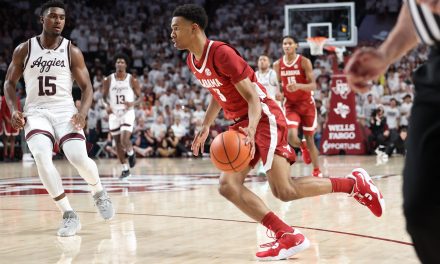By Brett Hudson
Some of football’s biggest innovators include Emory Bellard, Red Hickey, Walter Camp and Amos Alonzo Stagg, for inventing the wishbone, shotgun, Power T and I-Form offenses, respectively. The glory may go to these coaches, but most recent of these innovators, Bellard, coached in the 1970s and 1980s, and Camp goes all the way back to the late 1800s.
The glory of football’s most recent innovator should belong to Nevada head coach Chris Ault, the inventor of the Pistol formation.
Ault invented the offense to combine the big play capabilities and aerial attack options of the shotgun formation with the running abilities of the I-formation of the Ace singleback formation.
He did this by having the quarterback line up four yards behind the center and have a running back behind him, about seven yards from the line of scrimmage, thus letting the QB see the defensive alignment from further back — making reads more easily but having the running back run downhill to the ball in a run play.
Ault did so very successfully, as you would know if you watched his Wolfpack last season, who dashed Boise State’s BCS dreams in a big upset on the way to a 13-1 record and a 20-13 win over Boston College in the Kraft Fight Hunger Bowl as the co-Western Athletic Conference champions.
This offense was wildly successful on the stat sheet, too. Last year, Nevada running back Vai Taua ran for 1,610 yards and 19 touchdowns. His quarterback, Colin Kaepernick, also ran the ball for 1,206 yards and 20 touchdowns while keeping the aerial attack deadly, throwing for 3,022 yards and 21 touchdowns with only eight interceptions.
The offense clearly showcased his talents since the San Fransisco 49ers traded up in the draft to take Kaepernick with the 36th overall pick in the 2011 NFL Draft.
The offense has spread like wildfire throughout college football and even the NFL, now being utilized by the UCLA Bruins, Detroit Lions, Kansas City Chiefs and, of course, the Alabama Crimson Tide.
Thus far, Alabama has seen success from using the Pistol formation, as evidenced by most of the 2009 BCS National Championship season.
Mark Ingram’s go-ahead touchdown in the fourth quarter against Virginia Tech came out of the Pistol. Three touchdowns against Florida International in 2009 came out of the Pistol, and North Texas gave up 229 yards to the Pistol in 2009, according to a Tuscaloosa News unofficial count.
Trent Richardson has had some success out of the formation, too. His run against Arkansas, in which he broke four tackles, two behind the line of scrimmage, and outran at least two more (yes, the one that made the tradition video), came out of the Pistol formation.
The Pistol is one of the most versatile offensive formations in use right now, and it is more important to Alabama’s success this year and in the future than many fans realize.
It starts with head coach Nick Saban’s modern recruiting. In Alabama’s history, all Alabama has needed was an offensive line and a good running back to make national championships possible. National championship quarterbacks Jay Barker (1992) and Greg McElroy (2009) were better game managers than anything else.
It has been said that Alabama quarterbacks don’t have to win games, they just have to not lose them. It makes sense, when you think about it. When you have running backs as good as Alabama has had throughout its history, as long as the QB didn’t throw interceptions in obvious passing situations and got a few key first downs through the air, the game was won.
Now, under Saban, Alabama has talent at the quarterback position that can win football games, going beyond simply not losing them. This gives Alabama the potential for a very big threat offensively: perfect run-pass balance. Why not use it?
Breaking things down, Alabama has the perfect setup to run the Pistol offense to perfection. Offensive linemen Barrett Jones, D.J. Fluker and William Vlachos are experienced and show a great level of balance in run blocking and pass blocking skills, giving the Tide an edge in the trenches in a balanced Pistol offense. This will continue in years to come with upcomers such as Cyrus Kouandjio.
In the aerial attack, AJ McCarron is known especially for his deep ball, which works perfectly with the speed Alabama has at wide receiver, especially in youth such as Marvin Shinn and Danny Woodson, Jr.
When the deep ball is covered, McCarron can always go to the play action pass, which often uses crossing routes to big targets such as 6-foot-4, 210-pound Duron Carter.
To compliment the play action pass, Alabama will always have the running game, the traditional Alabama bread-and-butter with Trent Richardson, Eddie Lacy, Jalston Fowler and Dee Hart, when he returns from his knee injury.
With all these weapons that complement each other so well, the Pistol is the obvious choice. Balance on offense is extremely hard to defend, since at any time the run or the pass can get the yards necessary to keep the drive alive, and the Pistol is the most balanced alignment seen in college football today.
If the experts are correct in thinking national championships are in Alabama’s future, it’s safe to say the Pistol is in the future, too.


